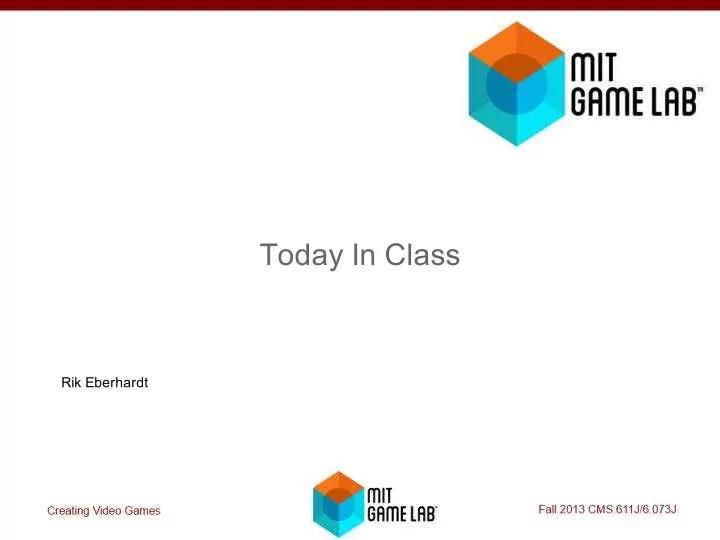

Today In Class Rik Eberhardt
Today In CMS.611 / 6.037 & SIT IN YOUR TEAMS ❖ Working in Teams Effectively ➢ Agile Review ➢ Team Dynamics ➢ How do distributed agile teams perform? ❖ Work in Class
Review & ❖ Agile Processes ➢ Iterative development
Review & ❖ Agile (Scrum) Processes Based On: & ➢ Transparency ■ & common nomenclature ➢ Inspection & ■ of artifacts (backlog) & ■ & during meetings ➢ Adaptation ■ & processes change
Agile Manifesto & ❖ Manifesto: ➢ Individuals and interactions over processes and tools ➢ Working software over comprehensive & documentation & ➢ Customer collaboration over contract negotiation ➢ Responding to change over following a plan ❖ Focus today: ➢ Individuals ➢ Interactions
What is a Team? & ❖ Collection of & individuals & ❖ Working toward a common purpose ❖ Shared responsibility for common outcomes
Teams Evolve over Time & ❖ All ‘small’ groups evolve over time based on interpersonal relationships and task behaviors ❖ Multiple theories exist to describe, all have common themes: ➢ getting to know each other ➢ experiencing conflict (positive & negative) ➢ roles shift based on knowledge & experience & ➢ (consensus, moving forward, decisions happen here)
One model: Tuckman (1965) ❖ One model that we use to evaluate teams: ➢ Forming ➢ Norming ➢ Storming ➢ Performing ❖ Each phase has items you can identify Used to figure out where you are now
FORMING ❖ People want to get along/be accepted ➢ Serious problems usually avoided ❖ Team learns about challenges & goals ❖ Not much gets ‘done’ in this stage
STORMING ❖ People able to express discontent ❖ Opinions are challenged ➢ Can be contentious, unpleasant ❖ To advance ➢ Tolerance & Patience ➢ Establish lines of trust and open communication Create processes!
NORMING ❖ Individuals start giving up their own ideas and goals - move towards a team goal ➢ Team members start taking responsibility ❖ Rules are established Process is being used! BUT: controversial ideas might be unspoken
PERFORMING ❖ Functioning as a unit, efficiently ❖ Team members are: ➢ autonomous when they can be ➢ dissent is expected and addressed You might not get this far - that’s okay!
The Model in Practice ❖ Non-linear ➢ movement between phases depends on task forming storming performing norming Image by MIT OpenCourseWare
Problems with the model ❖ All symptoms - no Triggers ❖ When does change happen? ➢ When does the team move from stage to stage? ➢ How can a team initiate a move intentionally? How have you seen changes in your teams?
Team Dynamics ❖ Teams are composed of Individuals ❖ Each person influenced by: ➢ Personal Development ➢ Motivation ➢ Morale / Self-worth ➢ Empowerment ➢ Commitment ➢ Trust ➢ Stress
Team Dynamics ❖ Desire / ability to learn new skills ➢ Personal Development - career & future needs ➢ Motivation - (intrinsic) enthusiasm ➢ Morale / Self-worth - self-awareness of skill ❖ Desire / ability to take on a task ➢ Empowerment - control over own work ➢ Commitment - displays of loyalty to the team ➢ Trust - between team members ➢ Stress
How do Distributed Teams Perform? ❖ What has worked for you so far?
‘One Team’ Mindset ❖ Actions that help the team identify as a Team, not as a group ➢ Frequent (social) Team Interactions ❖ Daily Standup ➢ Teams separated by time zone & oceans do this! ➢ Requires some personal sacrifice ■ Commitment - showing up to meetings ■ Trust - not letting meetings take to long
Co-located Work ❖ Working together to ➢ Reduce communication time ➢ Establish/maintain unity/one team ❖ Done as needed, when needed: ➢ At the beginning of the project ➢ Important milestones ➢ In strike teams ➢ Video chat
Coaches ❖ One person on the team, dedicated to: ➢ Cultivate team spirit ➢ Emphasize importance of ‘one team’ ➢ Could be your Scrummaster / Producer but: ■ Not focused on measured productivity (completing tasks) ■ Instead, focused on reading individuals ➢ One-on-one meetings could work ■ Coffee, lunch - social interactions
Agile Meetings ❖ Before the Sprint ➢ Planning - what are you working on this week? ❖ During the Sprint ➢ Daily Standup - what did you do? what is on fire? what is in your way? ❖ After/End the Sprint ➢ Sprint Review - what did you do this week? ➢ Sprint Retrospective - how did you work this week?
Meet Face to Face! ❖ Daily Standup ➢ let your teammates know you’re committed! ❖ Sprint Retrospectives ➢ talk about your feelings! (easier to say/hear than write/read)
Do this now: ❖ Schedule your next Sprint Retrospective ❖ A time period that everyone on the team can attend that is: ➢ At the end of a Sprint ➢ Before you start your next Sprint ➢ Focused on your processes ➢ Includes time to talk about feelings and interpersonal matters ■ Communicate about Communicating!
References ❖ Tuckman, Bruce (1965). "Developmental sequence in small groups". Psychological Bulletin 63 (6): 384–99. doi:10.1037/h0022100. PMID 14314073 ❖ Dorairaj, S., Noble, J., and Malik, P (2008). “Understanding Team Dynamics in Distributed Agile Software Development” Agile Processes in Software Engineering and EXtreme Programming: 9Th International Conference , XP 2008, Limerick, Ireland, June 10-14, 2008 : Proceedings (Google eBook), pp 47-61 ❖ O’Connor, R., Shuib Basri, L. (2012). “The Effect of Team Dynamics on Software Development Process Improvement” International Journal of Human CapItal and InformatIon technology professionals July-September 2012, Vol. 3, No. 3. doi: 10.4018/jhcitp.2012070102
Recommend
More recommend